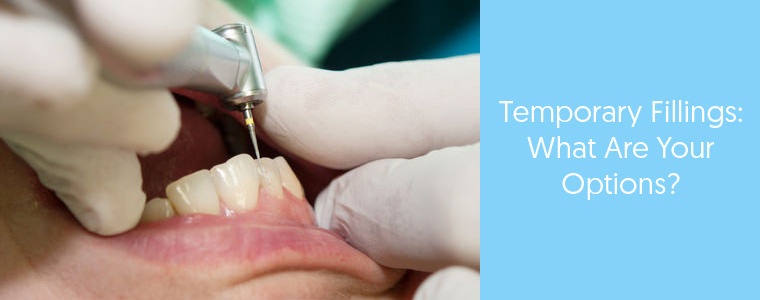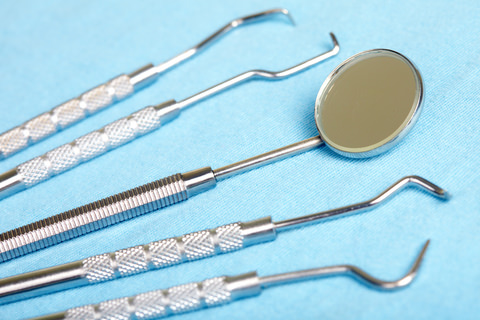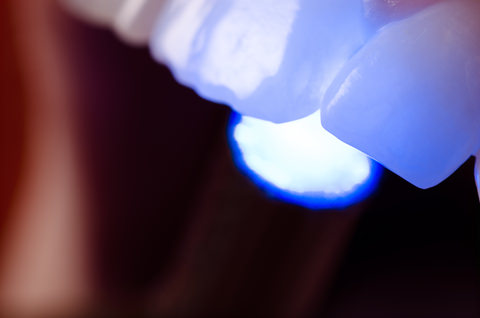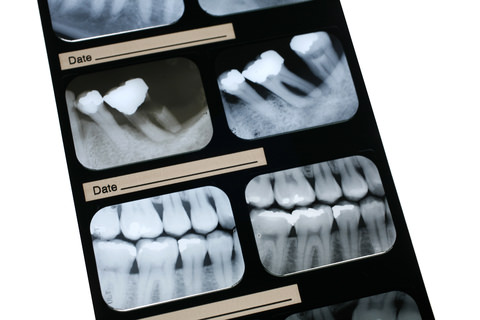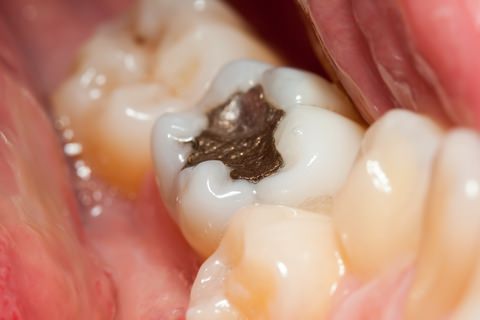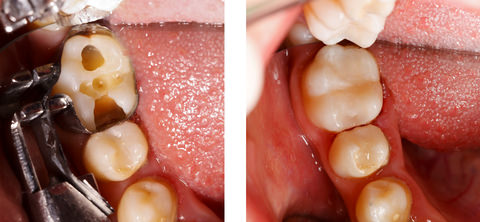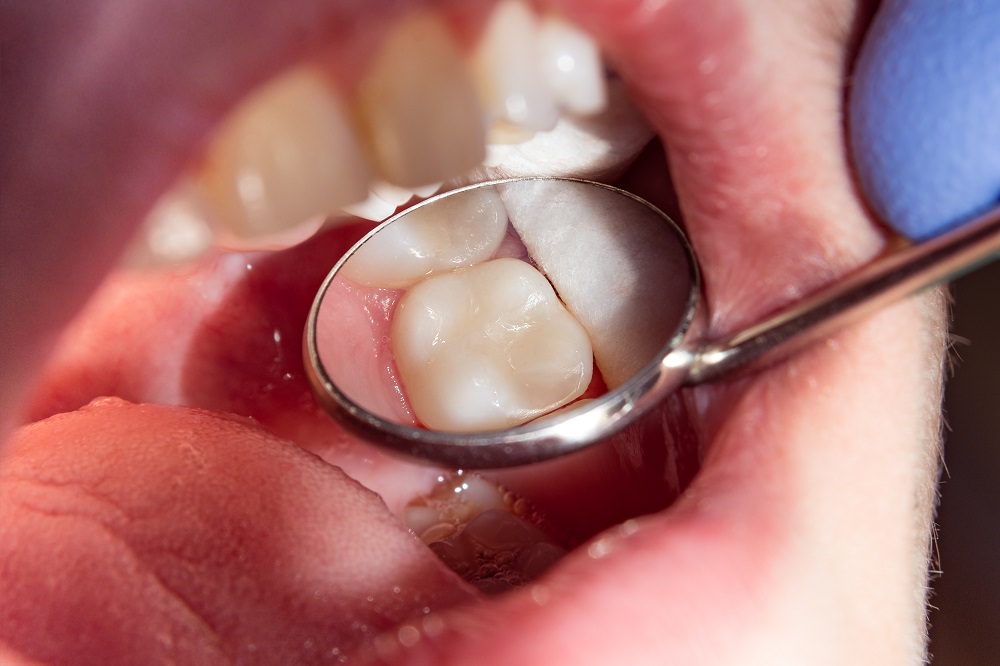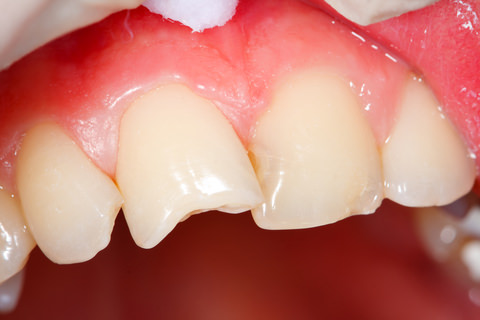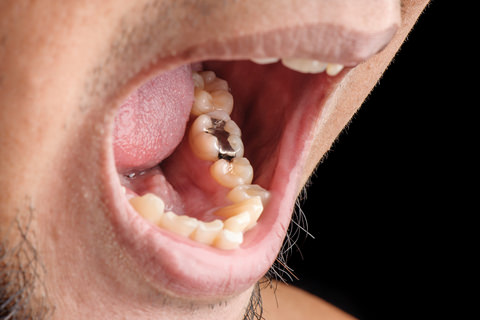What Are Your Temporary Dental Filling Options?
A temporary dental filling can be used by your dentist for many reasons, 9 at last count.
It is a dental treatment that is usually carried out by your dentist to buy some time until your tooth can be restored, permanently.
If I were to opt for a temporary filling, there are 3 main options to choose from:
- IRM or also known as zinc oxide-eugenol cement
- GIC which is short for Glass-ionomer cement
- Composite resin bonding
IRM Temporary Fillings
Made from zinc oxide and oils of clove, dentists will opt for IRM fillings if you need to return at a later date for further dental work.
It also helps to relax and sedate the nerve if decay is very close to that nerve.
IRM has the potential to block the tubules, and hopefully, your nerve can regenerate.
Glass-ionomer Fillings
GIC fillings are usually for fillings in primary teeth (first baby teeth).
Glass-ionomer is stronger and longer lasting than IRM fillings.
Because they’re a temporary measure, these fillings need to be redone at some point.
Not as long-lasting as composite resin, glass-ionomer are used for in-between root canal treatment appointments.
Composite Resin Fillings
Composite resin is regarded as a standard “filling” that a dentist will put into adult teeth. This type of filling can also be referred to as bonding.
As long as there is enough tooth structure to bond to, composites will make an excellent temporary measure if you require a dental filling.
How is a Composite Filling Done?
Composite is not as strong as amalgams or dental lab constructed materials such as Zirconia or E-max.
Fillings that are made from composite resin should be used in your posterior teeth that have a minimal surface area.
This is to stop possible fractures due to excessive and repetitive biting forces.
The video below shows a dentist placing a composite resin filling into a molar.
Temporary Fillings: Things to Consider
The type of temporary filling is dependent on when your return appointment is and whether the biting forces are strong.
If you have strong biting forces, excessive loss of teeth structure then a temporary crown can be fitted which is a strong acrylic.
In relation to children, are they cooperative. It can sometimes be challenging placing a filling in a child’s mouth.
Reasons for a Temporary Filling
There are many reasons why you can need temporary fillings.
What are they? Let’s take a look below.
- After urgent tooth care.
- After root canal therapy.
- To help reduce sensitivity after the first visit.
- During extensive decay, when several teeth are affected, and a restoration date is indefinite.
- Chipped/broken teeth.
- Teeth affected by wear and tear due to nail biting and grinding.
- To prevent shifting of the teeth.
- Let swelling reduce before restoration.
- To prevent gums and nerve exposure after dental work.
Various substances are used for fillings and no matter want substance is used they all seal the tooth and help restore its structure and function once your dentist removes the damage.
Some materials are better than others!
You can choose from diamond studded gold teeth to tooth-coloured composite resins to get your smile and confidence back.
Do You Need a Temporary Filling?
Your friendly dentist will recommend the substance that should be used for your filling.
They’ll consider its position, extent and the cost of repair when making this recommendation.
Your dentist will then use the following methods to choose the best material for your filling:
Observation
Dentists usually use an Explorer, which is a dental instrument; usually a thin metal rod with a (scary) sharp tip.
This metal instrument ‘explores’ your mouth, and is used to probe the areas surrounding the decay.
Discoloured spots on teeth could be signs of decay or simply stains from drinking coffee or smoking.
The Explorer makes sure your dentist locates all of your mouth’s decayed or prone to decay areas.
The white part of your teeth, known as enamel, is sturdier in comparison to decayed enamel.
The softened enamel dents in ever so slightly when probed with the Explorer.
Dentists use the Explorer with the utmost care, as pressing too hard can damage healthy teeth and even spread bacteria from rotten teeth to healthy ones.
Cavity-rinsing Dye
Cavity-rinsing Dye works like litmus paper, except the decay acts as the litmus.
The dye sticks to damaged teeth while leaving healthy teeth as clean as before.
X-Rays
X-rays are particularly useful in detecting decay building up in the soft dentine (covered by enamel) and where one tooth meets the other.
However, x-rays cannot detect smaller caries (decay and crumbling on teeth) on top surfaces.
Additionally; prior fillings make it impossible to detect underlying cavities.
Types of Fillings Available
Thanks to technology, various substances are used to make fillings.
Dental fillings can be made from a host of materials and depending on your personal circumstance, there’s a few to choose from.
- Amalgam: Assimilation of mercury, silver, tin, copper.
- Cast gold.
- Porcelain and Porcelain fused with metal.
- Composite Resin.
- Glass-Ionomer.
- Dental Lab constructed materials like Zirconia and E-max.
Silver Amalgam
Amalgam fillings have been used since the 1820s.
Silver is a transition metal and has the highest capability of conducting electricity and heat.
An interesting fact worth noting.
Due to its silver colour, it is also highly reflective and can be seen in your mouth.
Not very aesthetically pleasing to the eye you may say.
Advantages
- As it is a metal, silver amalgam fillings are durable and can last up to 10/15 years
- Is not expensive
- Is sturdy and can withstand chewing pressure
Disadvantages
- Silver amalgam fillings are not aesthetically pleasing as they cannot be tooth coloured.
- They take more space. Your dentist may need to remove some of your healthy tooth structure to make space for the filling.
- The metal may cause discolouration in the surrounding areas, visible as a greyish undertone.
- Can cause allergic reactions due to the mercury content in the amalgams.
- Amalgam fillings can expand and contract more than other substances, making it easier to crack or fracture when drinking hot or cold fluids.
- There are a few dentists and scientists who believe that amalgam fillings are dangerous to your health.
Cast Gold
Gold is one of the most precious metals found on Earth and is durable and non-corrosive by nature.
Gold’s properties make it perfect for use as a dental filling.
Even though gold is a wonderful filling material to use, it’s not as trendy as it once was.
Shiny and expensive, it’s had its day!
Advantages
- Longevity – Can last up to 15 years.
- Does not wear and tear while chewing, is non-corrosive.
- Is used for aesthetic purposes.
Disadvantages
- Costs run high and can be 10x that of silver amalgam.
- Cannot be installed in one sitting.
- May induce galvanic shock when placed next to silver amalgam (a rare occurrence).
- The colour yellow is not perceived as pleasing to the eye.
Composite Resin Fillings
Composite resin fillings are like a form of hardened plastic.
In most cases when you’re on a budget or you don’t want to spend an arm and leg for dental work, a composite filling can be a solution.
Your dentist may see composite resin fillings as a temporary measure, and it’s something to be aware of!
Composite fillings don’t last as long as other forms of fillings.
Advantages
- As they are tooth-coloured, it is easier to find a shade that matches your existing teeth; this is particularly helpful when replacing visible teeth such as incisors and canines.
- Composite fillings will bond chemically with your tooth after a while, creating a sturdier structure.
- Composite fillings can be used to repair chipped and broken teeth as well, due to their versatility.
- Help to prepare for tooth-sparing (fitting of permanent dentures).
Disadvantages
- Composite fillings are not highly durable and may need to be replaced after 5 years.
- They are not particularly strong and may not withstand the force exerted during chewing.
- These fillings may take up to 30 minutes longer than amalgams.
- Due to their non-durability, may chip off the tooth.
- May cost twice as much as an amalgam filling.
Porcelain/ Ceramic fillings
Porcelain fillings will give you a lovely finish and most times, blend in with your teeth.
They are more expensive than the temporary filling types such as composite and glass-ionomer.
Advantages
- These fillings are durable and can last up to 15 years.
- Resistant to staining.
- Aesthetically pleasing.
Disadvantages
- The cost runs parallel to the cost of gold fillings.
- Highly abrasive.
- Porcelain can chip and crack easily, depends on where in the mouth it is.
Glass Ionomer
These are made by integrating acrylics with a special glass material and are used mainly in fillings that run deep (below the gum line) and for children.
Advantages
- These fillings release fluoride which helps in the fortification of your teeth and the prevention of future decay.
- Much cheaper.
Disadvantages
- The material is not strong, weaker than composite resin.
- High susceptibility to wear and tear, including cracks and fractures.
- Does not last long, generally can last up to 5 years.
- Costs are comparable to composite resin expenses; e., Twice as high as amalgam fillings.
What are Indirect Fillings
When your tooth cannot hold up a filling on its own but is not damaged enough to need a crown, you might need an indirect filling.
Indirect fillings are similar to composite resin fillings and can be inlays or on-lays.
The difference in their names represents where they are placed on the tooth.
These fillings are made in a laboratory after an indentation of your teeth has already been sent in; thus they may take two or three sittings.
In your first visit, the decayed area is cleaned up, and the dentist takes an impression of your teeth.
For the time being, your dentist fills the cleaned teeth with a temporary filling.
During your second visit, the dentist will remove your temporary filling and check the indirect filling for its size.
If it sits well in your mouth, your dentist will permanently place it there.
Inlays are installed between the bumps on your tooth’s surface.
On-lays are more complicated than inlays and may spread over multiple bumps found on the tooth’s surface.
Categorised also as partial crowns.
Direct Fillings
Direct Fillings follow the same procedure as indirect fillings.
Your dentist can fit them during one sitting as direct inlays, and they make on-lays in the dental office, which is always a good thing.
The use of these fillings depends on the strength and amount of tooth structure left.
Are Silver Amalgam Fillings Safe?
Silver amalgam contains elemental mercury which turns to vapour at room temperature.
If you inhale too much, the mercury vapours enter through the lungs and over time, mercury inhalation can cause paralysis, agitation, and even sleep disorders.
There isn’t much research yet on how mercury in amalgam affects pregnant women or children under the age of 6.
On the plus side, the average amount of mercury found in breast milk (due to amalgams) falls well under the limit proposed by the Environment Protection Agency (EPA).
Currently, there are two schools of thought on amalgam fillings.
The Australian Dental Association have pronounced mercury used in amalgams is safe for adults and children over the ages of 6.
No link has been found yet, which connects amalgam fillings to poor health. So technically makes them a safe, durable and affordable option for the rehabilitation of the molars and premolars.
With that being said, a lot of dentists’ will choose not to use this type of material for dental fillings.
Not only because of aesthetic reasons but because there are better options out there to use.
How to Care for Your Fillings
Whether you have fillings or not, dental hygiene is an important part of life.
Food particles that get stuck in your teeth begin to rot if not cleaned away.
When you have fillings (or even braces), oral hygiene is a lot more difficult.
You may have to visit your dentist for a thorough cleaning and ask for a special toothbrush.
Our teeth, as we get older begin to deteriorate, this is due to natural wear and tear.
Using fluoride-based toothpaste help strengthen the teeth and keep enamel healthy and white.
Your Dentist is Your Friend
Instead of being afraid of your dentist, you should be open about the difficulties you face related to your teeth.
If you can’t talk to a professional, who can you talk to?
Trips to the dentist should be a 6 monthly occurrence instead of a yearly visit.
A regular dental check-up can help detect tooth-related issues before they begin to escalate.
Decay can begin to form around your filling; your dentist can fix this before you find your filling pop out while chewing!
All fillings have a life cycle, and regular visits help determine when the best time to replace or restore them.
Delaying to fix a chipped filling in time can make the situation worse.
You could lose the tooth or possibly need a root canal!
If your filling has fallen out, exposing your nerve, you could possibly need a root canal.
Although this can be painful, anaesthesia or nitrous oxide is given to patients, to reduce anxiety and pain levels.
The dentist then tops your tooth with a crown which makes it sturdier.
In severe cases, there may be no other way to save your tooth other than extraction.
But this is no cause for tears!
Thanks to modern medicine, you can get fixtures identical to your natural teeth, and no one will ever know the difference!
Conclusion
Medical developments have brought many new options for dental filling materials.
Suitable for your aesthetic and budget needs, a temporary filling will provide you with a solution while you decide on the next steps.
If you feel that you may need a filling or know you have tooth decay, make an appointment to see your dentist as soon as possible.
A temporary filling will hopefully start you off in the right dental direction.
Have you ever had a filling in any of your teeth? If so which kind did you opt for and why?
By Dr. V
Created at September 27, 2018, Updated at January 25, 2025


